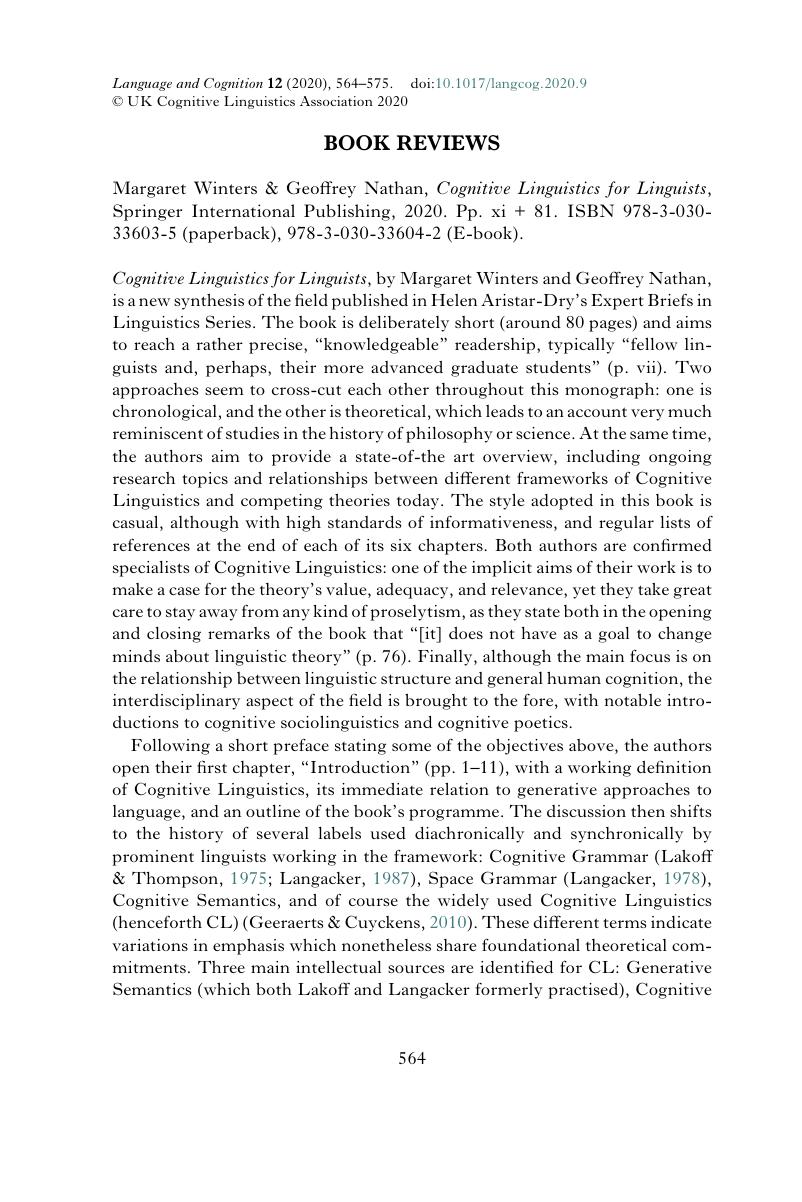No CrossRef data available.
Article contents
Margaret Winters & Geoffrey Nathan, Cognitive Linguistics for Linguists, Springer International Publishing, 2020. Pp. xi + 81. ISBN 978-3-030-33603-5 (paperback), 978-3-030-33604-2 (E-book).
Published online by Cambridge University Press: 03 April 2020
Abstract
An abstract is not available for this content so a preview has been provided. Please use the Get access link above for information on how to access this content.

- Type
- Book Review
- Information
- Copyright
- © UK Cognitive Linguistics Association 2020
References
REFERENCES
Achard, M. (2007). Complementation. In Geeraerts, D. & Cuyckens, H. (eds), The Oxford handbook of cognitive linguistics (pp. 782–802). Oxford: Oxford University Press.Google Scholar
Brugman, C. (1981). Story of over. Bloomington, IN: Indiana University Linguistics Club.Google Scholar
Chomsky, N. (1967 [1959]). A review of B. F. Skinner’s Verbal behavior. In Jakobovits, L. & Miron, M. (eds), Readings in the psychology of language (pp. 142–143). Englewood Cliffs, NJ: Prentice-Hall.Google Scholar
Deane, P. (1992). Grammar in mind and brain: explorations in cognitive syntax (Cognitive Linguistics Research). Berlin & New York: Mouton de Gruyter.CrossRefGoogle Scholar
Fauconnier, G. & Turner, M. (2002). The way we think: conceptual blending and the mind’s hidden complexity. New York: Basic Books.Google Scholar
Fillmore, C. (1988). The mechanisms of ‘Construction Grammar’. In Axmaker, S., Jaisser, A. & Singmaster, H. (eds), Proceedings of the Fourteenth Annual Meeting of the Berkeley Linguistics Society (pp. 35–55). Berkeley, CA: Berkeley Linguistics Society.Google Scholar
Fillmore, C., Kay, P. & O’Connor, M. C. (1988). Regularity and idiomaticity in grammatical constructions: the case of let alone. Language 64, 501–538.CrossRefGoogle Scholar
Geeraerts, D. (1988). Cognitive grammar and the history of lexical semantics. In Rudzka-Ostyn, B. (ed.), Topics in cognitive linguistics (pp. 647–677). Amsterdam: John Benjamins.CrossRefGoogle Scholar
Geeraerts, D. & Cuyckens, H. (2010). The Oxford handbook of Cognitive Linguistics. Oxford: Oxford University Press.CrossRefGoogle Scholar
Goldberg, A. (1995). Constructions: a construction grammar approach to argument structure. Chicago, IL & London: University of Chicago Press.Google Scholar
Lakoff, G. (1977). Linguistic gestalts. Proceedings of the Chicago Linguistic Society 13, 236–287.Google Scholar
Lakoff, G. & Johnson, M. (1980). Metaphors we live by. Chicago: Chicago University Press.Google Scholar
Lakoff, G. & Thompson, H. (1975). Introducing cognitive grammar. Proceedings of the First Annual Meeting of the Berkeley Linguistics Society 295–313.Google Scholar
Langacker, R. (1978). The form and meaning of the English auxiliary. Language 54, 853–882.CrossRefGoogle Scholar
Langacker, R. (1982). Space grammar, analyzability and the English passive. Language 58, 22–80.CrossRefGoogle Scholar
Langacker, R. (1984). Active zones. Proceedings of the Berkeley Linguistics Society 172–188.CrossRefGoogle Scholar
Langacker, R. (1987). Foundations of Cognitive Grammar. Volume 1: theoretical prerequisites. Stanford, CA: Stanford University Press.Google Scholar
Lindner, C. (1982). What goes up doesn’t necessarily come down: the ins and outs of opposites. Proceedings of the Chicago Linguistic Society 18, 305–323.Google Scholar
Rosch, E. (1975). Cognitive representations of semantic categories. Journal of Experimental Psychology: General 104, 192–233.CrossRefGoogle Scholar
van Hoek, K. (1997). Anaphora and conceptual structure. Chicago, IL: Chicago University Press.Google Scholar
Winters, M. (1989). Diachronic prototype theory: on the evolution of the French subjunctive. Linguistics 27, 703–730.CrossRefGoogle Scholar





